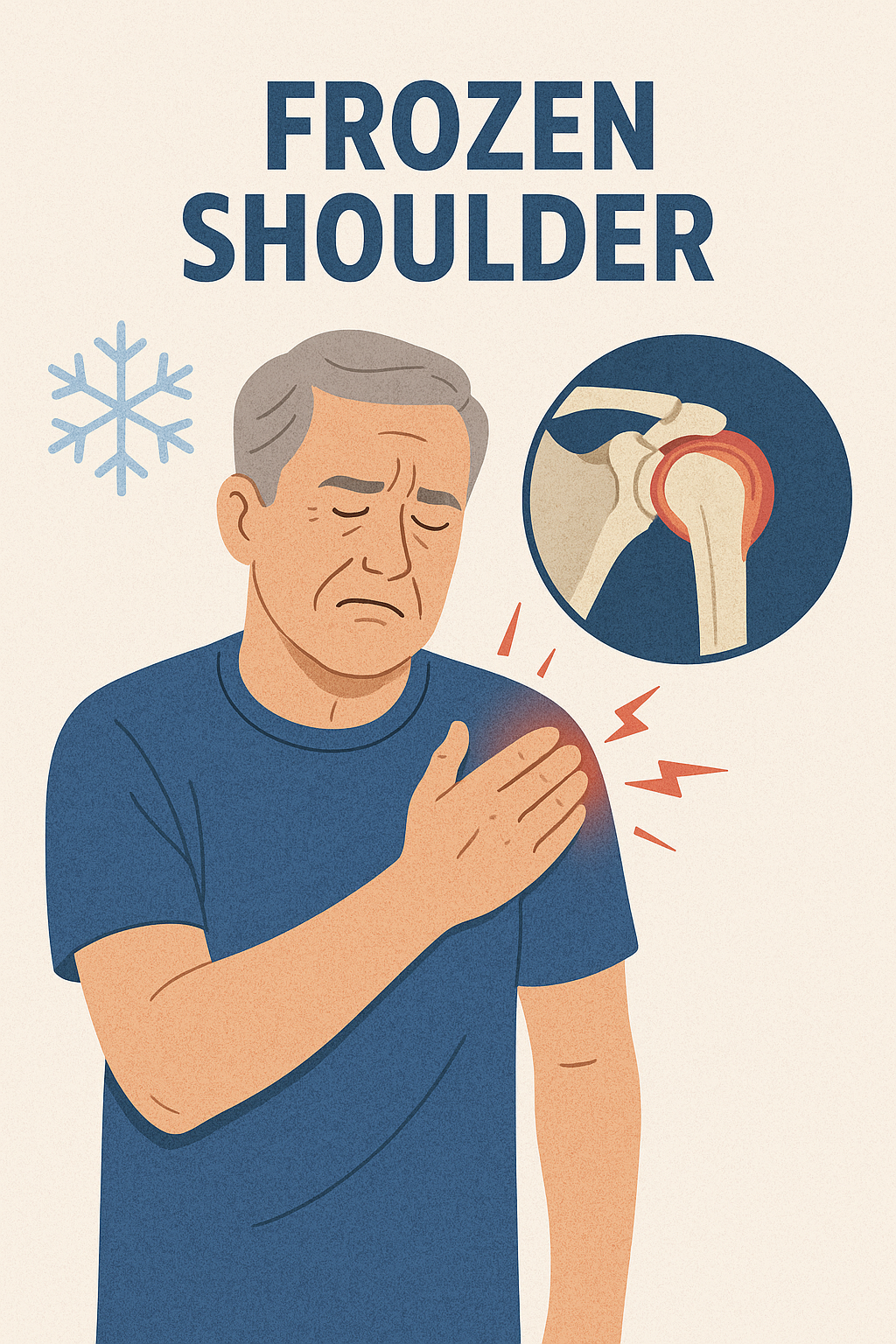A real-world story about frozen shoulder, and how we helped it thaw — with movement, patience, and the right treatment.
A few months ago, my uncle, Madhan — a retired schoolteacher — called me with a complaint:
“I can’t lift my arm, beta… not even to wear my shirt. It just won’t move.”
At first, we thought it was just a sprain. But as days passed, his shoulder pain worsened. It stiffened, became hard to move, and even turning in bed became painful. Something as simple as combing his hair was impossible.
When he finally saw a doctor, the diagnosis was clear:
Frozen Shoulder — or Adhesive Capsulitis, as they call it.
What is Frozen Shoulder?
Frozen shoulder, also called adhesive capsulitis, is a condition where your shoulder becomes stiff, painful, and hard to move. It happens when the tissue around the shoulder joint becomes thick, tight, and inflamed — like it’s “frozen.”
It develops slowly and can last months or even years if not treated early.
The Slow Freeze
Frozen shoulder doesn’t strike suddenly. It creeps in quietly — starting with discomfort, then stiffness, and then complete restriction of movement. It can take months or even years to heal if ignored.
Madhan’s problem started after a small fall. He “rested” his shoulder for weeks, thinking it would get better. That prolonged immobility was the start of his trouble.
He isn’t alone. Frozen shoulder mostly affects:
- People over 40
- More women than men
- And especially those with diabetes, thyroid problems, or other long-term health issues
- Shoulder surgery, injury, or fracture and didn’t move the arm much afterward
- Stroke or other condition that reduced arm movement
What Happens in Frozen Shoulder?
Think of it like this: The soft tissue capsule around the shoulder joint becomes thick, tight, and inflamed. It’s like your shoulder is wearing a tight shirt from the inside — one that won’t let you lift or rotate your arm.
It usually goes through 3 stages:
- Freezing – Pain increases, movement reduces
- Frozen – Less pain, but extreme stiffness
- Thawing – Slow improvement over time
But all three stages can stretch across a year or more — unless you catch it early.
Common Symptoms
- Dull, aching pain in the shoulder
- Stiffness
- Limited movement (can’t lift arm overhead, reach behind back, etc.)
- Worse pain at night
- Slowly getting worse over time
🩺 What are the Treatment Options?
Conservative (Non-Surgical) Treatment Options
In most cases, frozen shoulder can be treated without surgery. Here are the most effective ways:
🔹 1. Home Exercises & Physiotherapy
This is the most important treatment!
- Helps improve motion and reduce stiffness
- Start with gentle movements like:
- Pendulum swings
- Wall climbs
- Towel stretches
- Shoulder rolls
💡 Consistency is key. Even 10–15 minutes daily can make a difference.
🔹 2. Heat or Cold Packs
Use warm packs before exercises to loosen the joint
Apply ice packs after exercise to reduce pain or swelling
🔹 3. Pain Relief Medications
- Medicines like ibuprofen or paracetamol can help manage pain
- Use them as prescribed, especially before exercises
🏥 When to Consider Injection Therapy
If there’s no improvement after months of therapy, doctors may suggest:
Steroid Injections
- If pain is severe, a corticosteroid injection in the shoulder can reduce inflammation
Hydrodilatation (Capsule Stretching Injection)
- A special injection where fluid is used to gently stretch the tight shoulder joint
🏥 When to Consider Advanced Treatment
If there’s still no improvement, doctors may suggest:
- Manipulation Under Anesthesia (MUA) – Shoulder is moved under anesthesia to break stiffness
- Arthroscopic Release – Keyhole surgery to cut the tight tissue
But these are rarely needed — most people recover well with conservative care.
What Helped Uncle Madhan? (Hint: Not Just Medicine)
(And What Finally Unlocked His Shoulder)
Initially, the doctor started him on home exercises — things like:
- Arm pendulum swings
- Wall climbing with fingers
- Towel stretches behind the back
He also used heat packs before exercises, and took mild painkillers to help him move.
But progress was very slow. After a month, he was still stuck in the “freezing” phase — too much pain, not enough movement.
The doctor suggested a corticosteroid injection along with Hydrodilatation, placed directly into the shoulder joint. It took just 10 minutes.
Within a week, the pain reduced significantly. For the first time in months, Madhan could do his stretches without wincing. He could sleep better. He felt hopeful again.
“It felt like someone had pressed the reset button,” he later said.
The next good thing he did was what the physiotherapist showed him: Simple Shoulder Movements.
- letting his arm dangle and swing (pendulum)
- climbing a wall with his fingers — his shoulder slowly began to loosen.
He also learned to:
- Use a hot pack before exercises
- Take a painkiller before stretches so he could do more
- Breathe through the pain and not give up halfway
Within a month, he could reach the top shelf again.
Lessons He Wished He Knew Earlier
Madhan said something important over tea one day:
“If I had just kept moving my shoulder in those first few days… maybe this wouldn’t have happened at all.”
So here are his takeaways, which might help someone reading this:
1. Keep Moving the Shoulder
If you’re resting after an injury or surgery, don’t let your shoulder stay still for too long. Even small movements help.
2. Start Physiotherapy Early
Begin simple exercises as soon as your doctor allows, especially after surgery or fractures.
3. Control Blood Sugar
If you have diabetes, managing your sugar levels reduces the risk of developing joint stiffness.
4. Sit Up Straight
Good posture protects your shoulders. Avoid slouching while using your phone or working at a desk.
5. Stretch Daily
Simple stretches like pendulum swings, towel stretches, and arm circles keep the joint flexible.
6. Switch Sleeping Positions
Avoid sleeping on the same shoulder every night. Try lying on your back or alternating sides.
💬 Final Words
Frozen shoulder can feel frustrating, but the earlier you start moving, the faster you’ll recover.
Remember:
- Don’t ignore shoulder pain that lasts more than a few weeks
- Don’t rest your shoulder too long after an injury
- And don’t wait to start exercises
Your best treatment is movement + patience + consistency.
One Year Later…
Today, Uncle Madhan is back to gardening, sweeping his yard, and lifting his little granddaughter without flinching.
He still stretches every morning — it’s now part of his daily routine.
And whenever someone complains of shoulder pain, he smiles and says:
“Don’t wait for it to freeze. Keep it moving. That’s the cure hiding in plain sight.”
Disclaimer: This article is for educational purposes only and is not a substitute for professional medical advice. Always consult your doctor before starting any new treatment.

